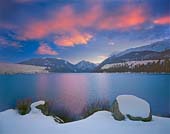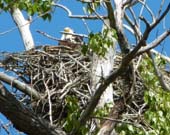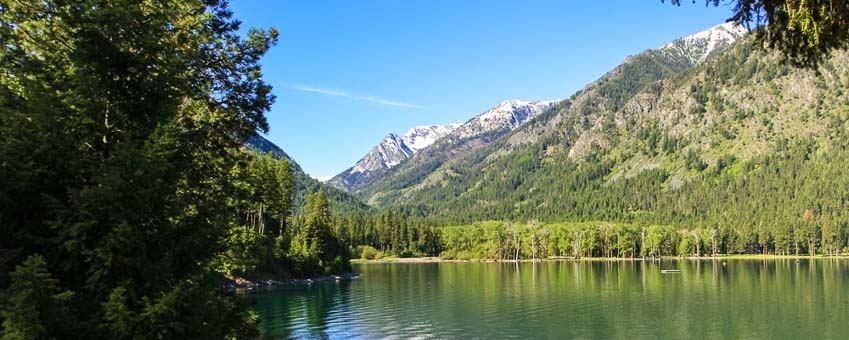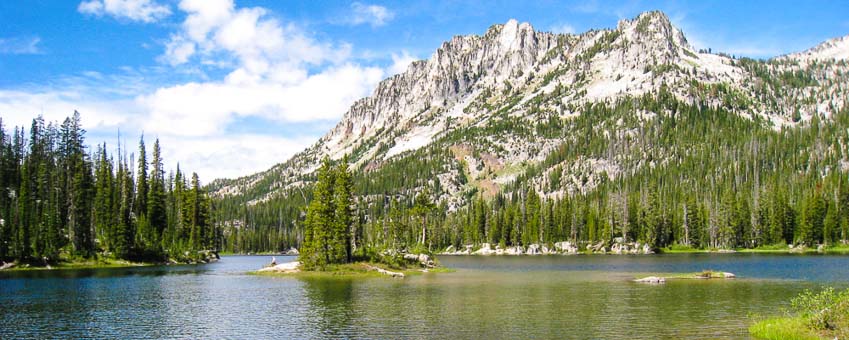About Wallowa Lake
In an alignment of perfect circumstance - climate, geology, and eons of time - converged to create the great moraines that form Wallowa Lake, a truly special place that awes everyone who first lays eyes upon it.
Referred to as “The Crown Jewel”, “The Sapphire in a Sea of Astounding Landscapes”, and the “WOW of the Wallowas.” Wallowa Lake has inspired passionate expression in words that for many ultimately fall short. You’ll find its iconic image featured in more articles on the area because it is the most loved destination in Northeast Oregon.
When you drive into the Wallowa Valley for the first time, the scene is a breathtaking experience in and of itself, but it’s at the end of the road where real treasure is found. This ribbon lake, with its crystal-clear, deep blue water and majestic mountain backdrop, creates yet another picture-postcard moment that few with a camera can resist. Add to that the crisp mountain air, the brilliant night sky, the emerald green valley and the warmth of its people and you have an experience that’s hard to find- no matter where you travel.
People claim there is a special energy to this place that will uplift your spirit and can even heal broken souls. Visitors often remark that being here feels like home, and for many it’s an experience that’s expressed in spiritual terms. Once you visit, there’s no going back- a piece of your heart will always remain.
The entire area between Hells Canyon and The Eagle Cap, including Wallowa Lake, was considered in the early 90’s for National Park designation. Wallowa Lake and the surrounding area is a truly magnificent place, like nowhere on Earth.
Take the Grand Tour: Fifteen Spherical 360 degree Panoramas of the surrounding area.
Family Favorite
This is a great place for families, with many activities that appeal to young and old alike. Take a spectacular tram ride and spend a lazy day strolling at the top of the world. Take the kids and play some miniature golf, ride a horse or play bumper boats; the opportunities for quality together-time abound. For many it’s a tradition that dates back generations.
The south end of the lake was developed starting in 1923 with an amusement park and the Wonderland Inn, now known as The Wallowa Lake Lodge. During those early days a ferry took people to the other side because there was no road. This historic lodge was featured in 2008 on the PBS series: Great Lodges of the National Parks.
With attractions for children, it still has a little of the amusement park air, though most visit now for the sheer natural beauty and to see the lively little art and western town of Joseph. Visit JosephOregon.com
Features and Facilities
Wallowa Lake State Park
At the south end you'll find one of Oregon’s most popular state parks. Before the reservation rules were changed it was almost impossible to get in because the same families reserved the same spaces year after year. Camping is open to RVs and tent campers and the park even has a few cabins and yurts for rent. There are 121 full hookup sites and 89 tent sites. Visit the Wallowa Lake State Park site.
Riverside Day Use Area > View Gallery
 The parks main day-use area is a beautiful 60 acre fee-free area that’s just east of the campground and is open to all visitors. Bordered on one side by the river and the other by the lake, this area has plenty of tables for a picnic, including an expansive open area for playing Frisbee or other ball games and plenty of other features for nature watchers, fishers, swimmers and sunbathers. The ancient forested grounds have paved trails and bridges that wind through beautiful mowed grounds. Along the river and out to the lake flume, Mother Nature takes over, providing visitors a taste of the wild. It is along here that the Kokanee spawn in late summer, their backs having turned a bright red.
The parks main day-use area is a beautiful 60 acre fee-free area that’s just east of the campground and is open to all visitors. Bordered on one side by the river and the other by the lake, this area has plenty of tables for a picnic, including an expansive open area for playing Frisbee or other ball games and plenty of other features for nature watchers, fishers, swimmers and sunbathers. The ancient forested grounds have paved trails and bridges that wind through beautiful mowed grounds. Along the river and out to the lake flume, Mother Nature takes over, providing visitors a taste of the wild. It is along here that the Kokanee spawn in late summer, their backs having turned a bright red.
Little Alps Day Use Area > View Gallery
About a mile up the road, almost to the trailhead, you'll find another day-use area. This forested spot is complete with picnic tables, a restroom and dirt trails that are stable enough for wheelchair access. This might be a good place if the main day use area is too busy for you or you just prefer the shade of a younger, thicker forest.
Wallowa Lake County Park > View Gallery
On the north end of the lake you’ll find the county day-use area. While not nearly as expansive, it’s equipped with a great double boat ramp, tie-up dock and a few picnic tables. The beach is ample and it has a protected swimming area for the kids. This sunny location, due to the prevailing breeze, is typically warmer for swimmers too. It’s also where the fireworks are launched just offshore for Independence Day. Lying on your back while the shells explode overhead, completely filling your field of view while listening to the echoes boom through the mountains, redefines the whole experience for most.
Wallowa Lake Trailhead > See the Hiking Page for more.
This is the gateway to the incredible Eagle-Cap Wilderness, Oregon's largest. From here you can park for free and obtain a free permit to stay, camp and hike in the wilderness. The primary trail is the West Fork Trail, which leads to Ice Lake, 6-Mile Meadow and the popular Lakes Basin area. The East Fork Trail leads to Aneroid and Bonny Lakes and beyond. The Chief Joseph Trail leads up to Chief Joseph Mountain and some of the best views overlooking Wallowa Lake.
Iwetemlaykin State Heritage Site > View Gallery
 About a half-mile north and adjacent to the Chief Joseph Memorial you'll encounter Sacred Land. This 62 acre site was finally protected in 2009 through the great efforts of The Nez Perce Tribe, the Confederated Tribes of the Colville Reservation, the Confederated Tribes of the Umatilla Indian Reservation and area locals. The trails are fairly gradual and graveled for casual hiking or running. A small pond, running stream and meadows are some of the features of this beautiful park, making it a great place for a short day hike. Wildlife are naturally attracted to this relatively undisturbed park, so keep an eye out- you may be surprised by what you discover!
About a half-mile north and adjacent to the Chief Joseph Memorial you'll encounter Sacred Land. This 62 acre site was finally protected in 2009 through the great efforts of The Nez Perce Tribe, the Confederated Tribes of the Colville Reservation, the Confederated Tribes of the Umatilla Indian Reservation and area locals. The trails are fairly gradual and graveled for casual hiking or running. A small pond, running stream and meadows are some of the features of this beautiful park, making it a great place for a short day hike. Wildlife are naturally attracted to this relatively undisturbed park, so keep an eye out- you may be surprised by what you discover!
Location
Wallowa Lake is located about one mile south of Joseph, Oregon, (pop. 1,081) and seven miles south of the largest town in the county, Enterprise (pop. 1,940). The closest major town is LaGrande, Oregon (pop. 13,102) about 1 ½ hour away. Driving distance from Boise, Idaho is about 4 ½ hours and from Portland, about 6 hours. This end-of-the-road, distant locale prevents the normal big-city onslaught that plagues most tourist destinations. You’ll find traffic to be relatively light on all but the busiest weekends.
Low Light Pollution means stars, Stars, STARS

With such a low population density and long distance to cities, Wallowa Lake sits in one of those ever-shrinking dark spots on the Earth. That, and the clear mountain air combine to make stargazing a delight, especially to those from metropolitan areas who never realize that the sky is filled with so many stars and that the cloud they think they’re seeing is really the Milky Way. Bring or load your star map or planisphere and spend some time learning the constellations while you catch the streaks of shooting stars. The Perseids meteor shower in mid-August is especially impressive.
Clean, Clear Water
 Despite having a wild mountain river feeding it with organic material and sediment, Wallowa Lake is remarkably clear and clean. On a calm day its easy to peer down and watch fish swimming along the bottom, allowing quiet fisherman to do a little 'see fishing.' Until 1994, the neighboring town of Joseph drew all its water from the lake without ill effect- it's that clean. So, if you're out swimming or skiing and you accidentally get a mouthful- have no fear, you'll probably be just fine.
Despite having a wild mountain river feeding it with organic material and sediment, Wallowa Lake is remarkably clear and clean. On a calm day its easy to peer down and watch fish swimming along the bottom, allowing quiet fisherman to do a little 'see fishing.' Until 1994, the neighboring town of Joseph drew all its water from the lake without ill effect- it's that clean. So, if you're out swimming or skiing and you accidentally get a mouthful- have no fear, you'll probably be just fine.
Geology
 Wallowa Lake is the largest of several glacial cirque lakes in the area. It was formed by repeated periods of glaciation that began some 3 million years ago and ended about 15,000 BC. The glaciers formed high in the Wallowa Mountains around Glacier Lake and moved down the East and West Fork of the Wallowa River. As these glaciers advanced and retreated they carved out the river valleys and carried down rocks and sediment forming the twin and terminal moraines which rise over the lake some 900’. Along the moraine ridges, large granite boulders called ‘erratics’ were left behind, a few as big as cars. The glaciers also deposited boulders across the area around Joseph which was named 'Hah-um-sah-pah', by the Nimiipu (Nez Perce), meaning 'big rocks lying scattered around.’
Wallowa Lake is the largest of several glacial cirque lakes in the area. It was formed by repeated periods of glaciation that began some 3 million years ago and ended about 15,000 BC. The glaciers formed high in the Wallowa Mountains around Glacier Lake and moved down the East and West Fork of the Wallowa River. As these glaciers advanced and retreated they carved out the river valleys and carried down rocks and sediment forming the twin and terminal moraines which rise over the lake some 900’. Along the moraine ridges, large granite boulders called ‘erratics’ were left behind, a few as big as cars. The glaciers also deposited boulders across the area around Joseph which was named 'Hah-um-sah-pah', by the Nimiipu (Nez Perce), meaning 'big rocks lying scattered around.’
Geologically, the Wallowa Lake Moraines are considered a near perfect example, and finally recieved protection and access to the public. Visit josephoregon.com for hiking information.
Size and Elevation
The lake is about 3.7 miles long and about 3/4 mile wide with a depth of 299 feet, which, for a lake of such size is very deep. In 1917 a local non-profit group of farmers built a dam that raised the lake level by about 28’. The dam has seen better days and is now under consideration for reconstruction using federal funds that would include fish passage, along with plans for bringing the migratory run of sockeye back that was extinguished with the dam’s original construction.
At an elevation of 4,372 ft, Wallowa Lake sometimes freezes solid in the winter and until it has had several weeks of warm weather it remains on the chilly side. The water warms enough for skiers and swimmers typically by early to mid-July although many still use a wetsuit.
Seasons & Weather
 Spring can be a real mix of weather. It typically starts with a feign of warm, dry weather in March or May that makes you think that summer is here. After several weeks of this we are usually treated to a few spring snows followed by a mini-monsoon spell that thoroughly soaks everything. This can last well into June but in its aftermath the most wonderful thing occurs: plants BOOM! The grass turns the most unreal electric-green and the hills take on color as well. Wildflowers bloom everywhere turning uncultivated fields into nature’s flower gardens. With the snow still thick on the mountains and the air crisp and cleaned, this is the most visually striking time to be here. It’s also the best time to fish for Kokanee.
Spring can be a real mix of weather. It typically starts with a feign of warm, dry weather in March or May that makes you think that summer is here. After several weeks of this we are usually treated to a few spring snows followed by a mini-monsoon spell that thoroughly soaks everything. This can last well into June but in its aftermath the most wonderful thing occurs: plants BOOM! The grass turns the most unreal electric-green and the hills take on color as well. Wildflowers bloom everywhere turning uncultivated fields into nature’s flower gardens. With the snow still thick on the mountains and the air crisp and cleaned, this is the most visually striking time to be here. It’s also the best time to fish for Kokanee.
 Summer daytime temperatures are typically warm to hot (80-95 F) and dry. At night temperatures usually fall quickly; sleeping in a hot uncomfortable bed is rare. These relatively comfortable temperatures are what drove the Nez Perce and today’s visitors to this area. ‘Going to the mountains’ is as much about escaping the awful heat of the lowlands as it is about seeing the mountains themselves. The third week in July is usually the hottest and by then the water has warmed up enough to take the edge off. During mid-July to late-August the temperature can reach the upper 90’s and if you’re swimming on the north or south beaches when the breeze is blowing towards them the water can get quite nice, even warm. Keep that in mind if your kids want to go swimming, but hate the cold.
Summer daytime temperatures are typically warm to hot (80-95 F) and dry. At night temperatures usually fall quickly; sleeping in a hot uncomfortable bed is rare. These relatively comfortable temperatures are what drove the Nez Perce and today’s visitors to this area. ‘Going to the mountains’ is as much about escaping the awful heat of the lowlands as it is about seeing the mountains themselves. The third week in July is usually the hottest and by then the water has warmed up enough to take the edge off. During mid-July to late-August the temperature can reach the upper 90’s and if you’re swimming on the north or south beaches when the breeze is blowing towards them the water can get quite nice, even warm. Keep that in mind if your kids want to go swimming, but hate the cold.
Weather is generally unpredictable in all mountain areas and even though early July daytime temperatures are usually in the lower 80’s, there have been several occasions where it’s snowed on Independence Day. So, don’t forget to pack a jacket, even in summer.
If you’re lucky, you may be treated to a thunderstorm. They’re quite different from other regions in that the mountains channel the sound and energy in spectacular ways. They’re not uncommon in the summer where the Wallowas make their own weather, especially when the airflow is from the south. They build up in the afternoon and can quickly change the conditions on the lake to one of churning, stormy seas- so it’s something to keep an eye on if you’re in a small boat. Chief Joseph’s original name was Hin-mah-too-yah-lat-kekt, meaning ‘Thunder Rolling Down the Mountain.’ Until you witness the lightshow and thunder that echoes through these mountains, you’ll never truly appreciate the tremendous power in that name.
 Fall is almost always the ‘Indian Summer’ variety. As the days shorten and the first frosts occur, the cottonwoods, alders and aspens change into their most wonderful colors. School starts and the number of visitors drops to a trickle. Warm fall weather can draw itself out clear to Halloween, with many days in the low 80’s making this usually-dry season a strong favorite of locals and visitors alike. Fall is also when the Swiss celebration of Alpenfest occurs, THE major event at Wallowa Lake.
Fall is almost always the ‘Indian Summer’ variety. As the days shorten and the first frosts occur, the cottonwoods, alders and aspens change into their most wonderful colors. School starts and the number of visitors drops to a trickle. Warm fall weather can draw itself out clear to Halloween, with many days in the low 80’s making this usually-dry season a strong favorite of locals and visitors alike. Fall is also when the Swiss celebration of Alpenfest occurs, THE major event at Wallowa Lake.
 The winters are long and fairly cold with temperatures in January ranging about 10 to 25 degrees during the day and dropping another 20 degrees at night. There are many brisk, sunny days with low humidity that are very enjoyable, especially if you’re engaged in some kind of exercise like skiing or snowshoeing. The Salt Creek Summit Sno-Park is a mecca for snowmobilers, skiers and snowshoers and is just a 45 minute drive, making lake lodging a good spot for your home base. If you enjoy downhill skiing and snowboarding, Fergi, the local ski area, is only about a half-hour away.
The winters are long and fairly cold with temperatures in January ranging about 10 to 25 degrees during the day and dropping another 20 degrees at night. There are many brisk, sunny days with low humidity that are very enjoyable, especially if you’re engaged in some kind of exercise like skiing or snowshoeing. The Salt Creek Summit Sno-Park is a mecca for snowmobilers, skiers and snowshoers and is just a 45 minute drive, making lake lodging a good spot for your home base. If you enjoy downhill skiing and snowboarding, Fergi, the local ski area, is only about a half-hour away.
Wildlife
 Bird life including eagles, osprey, geese, mergansers, various ducks, and the occasional swan or loon can be seen. There is a nesting pair of American Eagles that usually maintain a nest in an old cottonwood snag right on the south shore, for all to see. See our Bird Guide.
Bird life including eagles, osprey, geese, mergansers, various ducks, and the occasional swan or loon can be seen. There is a nesting pair of American Eagles that usually maintain a nest in an old cottonwood snag right on the south shore, for all to see. See our Bird Guide.
The area is home to large mammals: elk, deer, and in the mountains above, mountain goats. Smaller mammals include various kinds of squirrels, skunk, martins, mink, fox and river otters. Coyotes, cougar and black bear are somewhat common and reported wolf sightings are rare. See our Wildlife Guide.
 To the delight of visitors, Wallowa Lake has a sizable herd of mule deer that are very comfortable with their human inhabitants. They’re one of the first things people notice as they drive into the south end. Deer lounge around people’s campsites, often using awnings to escape the mid-day sun. Small bachelor groups of magnificent bucks roam around attracting a following of admirers. They seem so relaxed with it all, but don’t let this fool you; they’re still wild, even if they are sticking their heads inside your car to get a bite of apple. Most of the time they see us as benefactors, providing an easy handout; but all that can change quickly if, for instance, a doe thinks your dog might be threatening her fawn. In early fall Bucks go into the rut and get frisky and there have been a few attacks then too. The State Park recently enacted a ban on feeding all wildlife, believing that would make a difference; the jury is still out. The Fish and Game Department would rather you didn’t feed them citing the possibility of attracting cougars. The deer have taken the hint and many just moved into Joseph.
To the delight of visitors, Wallowa Lake has a sizable herd of mule deer that are very comfortable with their human inhabitants. They’re one of the first things people notice as they drive into the south end. Deer lounge around people’s campsites, often using awnings to escape the mid-day sun. Small bachelor groups of magnificent bucks roam around attracting a following of admirers. They seem so relaxed with it all, but don’t let this fool you; they’re still wild, even if they are sticking their heads inside your car to get a bite of apple. Most of the time they see us as benefactors, providing an easy handout; but all that can change quickly if, for instance, a doe thinks your dog might be threatening her fawn. In early fall Bucks go into the rut and get frisky and there have been a few attacks then too. The State Park recently enacted a ban on feeding all wildlife, believing that would make a difference; the jury is still out. The Fish and Game Department would rather you didn’t feed them citing the possibility of attracting cougars. The deer have taken the hint and many just moved into Joseph.
Explore
This is a vast and diverse area with environments that range from alpine to semi-arid desert. There are flat valleys, rugged canyons, razor sharp ridges and mountains over 10,000 feet. There are endless miles of dirt road (bring your maps and GPS) and approximately 500 miles of developed trails, just in the Eagle Cap! Go for a stroll and end up in blissful solitude surrounded in wilderness. Take an exhilarating drive to one of the lookouts. Spend an incredible day in ‘Big Sky’ country in the pristine grasslands of Zumwalt Prairie.
Learn More about the Wild Science of the area at 'Wallowlogy' -Wallowa County's Discovery Center
The Eagle Cap Wilderness is the largest wilderness in Oregon. Hells Canyon is the deepest canyon in North America. Wallowa County is home to some of the largest herds of elk and the only Wolves in the state of Oregon. This is wild country, as pure and untamed as it gets.






